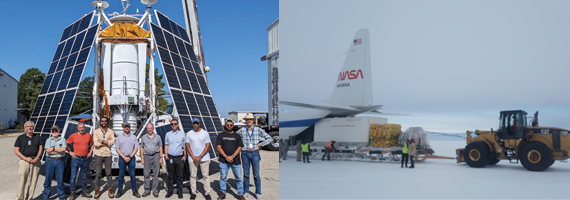
GUSTO Balloon Mission Arrives at McMurdo Station, Antarctica!
On October 17th, the GUSTO mission—led by UArizona professor Christopher Walker—passed an important milestone on its journey to its December launch: the KDP-E Review at NASA Headquarters approved the balloon telescope mission for flight. Following the NASA approval, technicians loaded the integrated gondola and telescope aboard a turboprop NASA aircraft in Texas to begin its long trip to Antarctica. Several team members, including PI Christopher Walker, will meet the telescope at McMurdo Station, where they will spend the next several weeks preparing the ballooncraft for a December launch.
This will be the culmination of a multi-year, multi-institute journey. NASA selected the GUSTO mission (the Galactic/Extragalactic ULDB Spectroscopic Terahertz Observatory) for the Explorer’s Program in 2017. Partners at the Johns Hopkins Applied Physics Laboratory and the Netherlands Institute for Space Research joined forces with the University of Arizona to build the gondola and detectors necessary for this unique telescope, which marries the strengths of space observation with the proximity of earth-based operations. When it launches in December, GUSTO will fly on a Long-Duration Balloon (LDB) 120,000 feet in the air above Antarctica to study the interstellar medium—the matter between the stars—using far infrared detectors. This data will help scientists determine the life cycle of interstellar gas in our Milky Way galaxy, witness the formation and destruction of star-forming clouds, and understand the dynamics and gas flow in the vicinity of the center of our galaxy.
Join us in congratulating the GUSTO team on this landmark achievement!

For Public
Public events include our Monday Night Lecture Series, world-reknowned Astronomy Camp and Mt Lemmon Sky Center.

For Students
A good place to start if you want to become an undergrad major or grad student, or need to find our schedule of classes.

For Scientists
Find telescopes and instruments, telescope time applications, staff and mountain contacts, and faculty and staff scientific interests.




